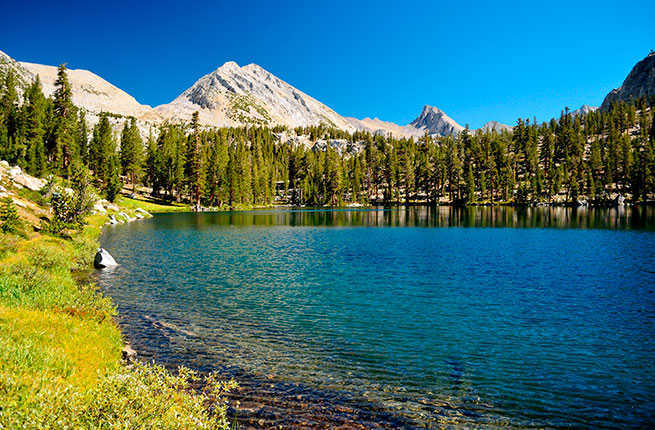
Yellowstone, Yosemite, the Grand Canyon—you’ve obviously heard of America’s most famous national parks, but did you know the National Park Service manages a whopping 59 parks? From coast to coast (with a couple of parks beyond those coasts), these protected areas represent the best of what this country has to offer. As writer Wallace Stegner said in 1893, “National parks are the best idea we ever had. Absolutely American, absolutely democratic, they reflect us at our best rather than our worst.” In honor of the 100th anniversary of the National Parks Service, we’re taking you on a tour of every single national park, all of which are breathtaking beauties in their own regard.
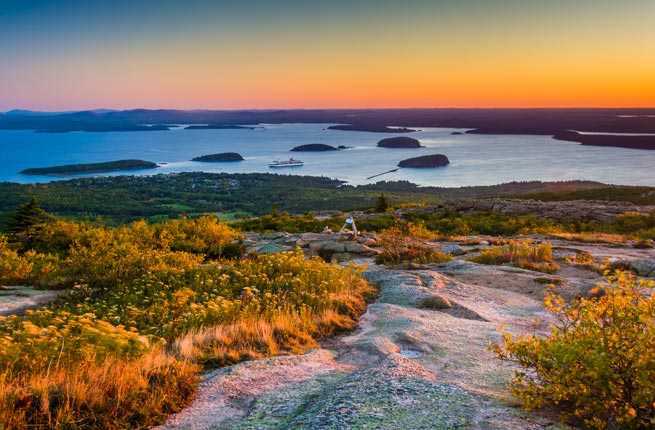
Acadia National Park, Maine
Maine
With about 49,000 acres of protected forests, beaches, mountains, and rocky coastline, Acadia National Park is the second-most-visited national park in America (after the Great Smoky Mountains National Park). According to the National Park Service, 2 million people visit Acadia each year. The park holds some of the most spectacular scenery on the Eastern Seaboard: a rugged coastline of surf-pounded granite and an interior graced by sculpted mountains, quiet ponds, and lush deciduous forests. Cadillac Mountain (named after a Frenchman who explored here in the late 1600s and later founded Detroit), the highest point of land on the East Coast, dominates the park. Although it's rugged, the park also has graceful stone bridges, miles of carriage roads (popular with walkers, runners, and bikers as well as horse-drawn carriages), and the Jordan Pond House restaurant (famous for its popovers).
PLAN YOUR TRIP: Visit Fodor’s Acadia National Park Guide
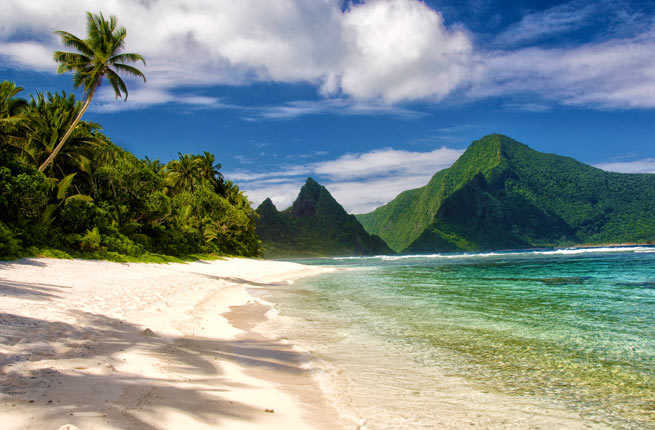
American Samoa National Park, American Samoa Territory
American Samoa
Spread over the main island of Tutuila and the Manu'a islands some 68 miles to the east, this national park is the southernmost in the U.S. park system. The most accessible section is the rainforest region in the north of Utilia, reached via a bumpy road to the town of Vatia from where several walks begin. The easiest is the 650-foot Pola Island Trail (Pola Island is also called Cockscomb due to its dramatic shape), while the most challenging is the three-hour round-trip trek to the summit of Mt. Alava for fantastic views over Pago Pago Harbor, the iconic Rainmaker Mountain, and Cockscomb. From the summit there's also a view of the Manu'a Islands, known for their excellent diving and rainforest walks. There are flights and boat trips to the Manu'a Islands; however, a guided tour is the best way to visit. The national parks office in Pago Pago is the best starting point for advice and maps. The staff can also advise on a Samoan homestay, an unusual opportunity to meet the locals and gain a real insight into island life and culture.
PLAN YOUR TRIP: Visit Fodor’s American Samoa Guide

Arches National Park, Utah
Utah
More than 1 million visitors come to Arches annually, drawn by the red rock landscape and its teasing wind- and water-carved rock formations. The park is named for the 2,000-plus sandstone arches that frame horizons, cast precious shade, and nobly withstand the withering forces of nature and time. Fancifully named attractions like Three Penguins, Queen Nefertiti, and Tower of Babel stir the curiosity, beckoning even the most delicate of travelers from roadside locales. Immerse yourself in this immense park, but don’t lose yourself entirely—summer temperatures frequently crack 100°F, and water is hard to come by inside the park boundaries.
PLAN YOUR TRIP: Visit Fodor’s Arches National Park Guide

Badlands National Park, South Dakota
South Dakota
So stark and forbidding are the chiseled spires, ragged ridgelines, and deep ravines of South Dakota's badlands that Lieutenant Colonel George Custer once described them as “hell with the fires burned out.” Although a bit more accessible than the depths of the underworld, the landscape is easily the strangest in the Great Plains. Ruthlessly ravaged over the ages by wind and rain, the 380 square miles of wild terrain continue to erode and evolve, sometimes visibly changing shape in a few days. Prairie creatures thrive on the untamed territory, and animal fossils are in abundance.
PLAN YOUR TRIP: Visit Fodor’s Badlands National Park Guide
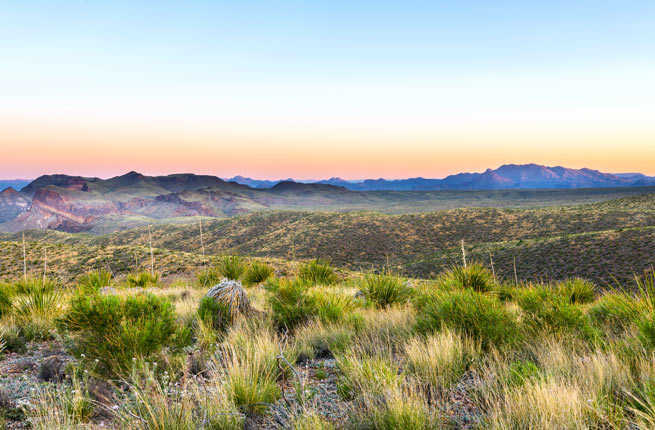
Big Bend National Park, Texas
Texas
Cradled in the warm, southwestern elbow of Texas, the 801,163 acres of Big Bend National Park hang suspended above the deserts of northern Mexico. From the craggy, forested Chisos Mountains rising up to almost 8,000 feet to the flat, stark plains of the Chihuahuan Desert, Big Bend is one of the nation's most geographically diverse parks, with the kind of dramatic backdrop that inspired Hollywood's first Western sets. Visitors can ride the rapids of the Rio Grande, trek through the classic, Old West landscape, and marvel at the moonscape that skirts Boquillas, Mexico.
PLAN YOUR TRIP: Visit Fodor’s Big Bend National Park Guide
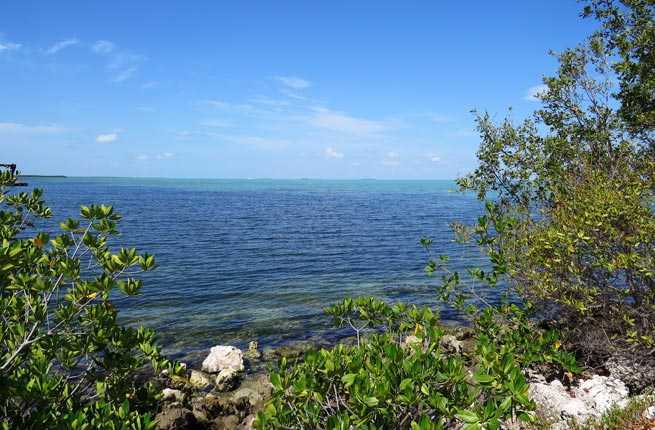
Biscayne National Park, Florida
Florida
Occupying 172,000 acres along the southern portion of Biscayne Bay, south of Miami and north of the Florida Keys, Biscayne National Park is 95% submerged, its terrain ranging from 4 feet above sea level to 60 feet below. Contained within are four distinct zones: Biscayne Bay, undeveloped upper Florida Keys, coral reefs, and coastal mangrove forest. Mangroves line mainland shores much as they do elsewhere along South Florida's protected waters. Biscayne Bay serves as a lobster sanctuary and a nursery for fish, sponges, crabs, and other sea life. Manatees and sea turtles frequent its warm, shallow waters. The park hosts legions of boaters and landlubbers gazing in awe over the bay.
PLAN YOUR TRIP: Visit Fodor’s Biscayne National Park Guide
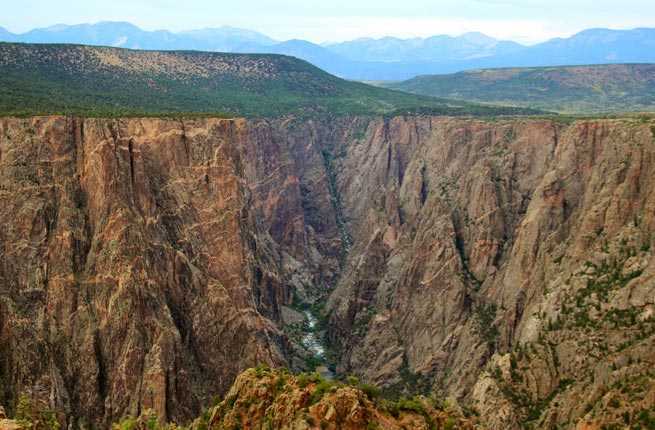
Black Canyon of the Gunnison National Park, Colorado
Colorado
The Black Canyon of the Gunnison River is one of Colorado's—and indeed the West's—most awe-inspiring places. A vivid testament to the powers of erosion, the canyon is roughly 2,000 feet deep. At its narrowest point, it spans 1,000 feet at the rim and only 40 feet at the bottom. The steep angles of the cliffs make it difficult for sunlight to fully break through during much of the day, and ever-present shadows blanket the canyon walls, leaving some places in almost perpetual darkness. No wonder it's called the “Black Canyon.”
PLAN YOUR TRIP: Visit Fodor’s Black Canyon of the Gunnison National Park Guide
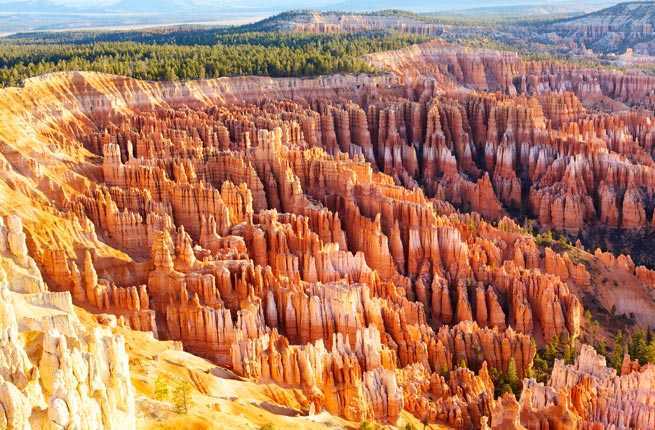
Bryce Canyon National Park, Utah
Utah
A land that captures the imagination and the heart, Bryce is a favorite among Utah's national parks. Although its splendor had been well known for decades, Bryce Canyon wasn't designated a national park until 1928. The park is named for Ebenezer Bryce, a pioneer cattleman and the first permanent settler in the area. His description of the landscape not being hospitable to cows has oft been repeated. Even more than his famous quote, however, Bryce Canyon is known for its fanciful “hoodoos,” best viewed at sunrise or sunset, when the light plays off the red rock.
PLAN YOUR TRIP: Visit Fodor’s Bryce Canyon National Park Guide

Canyonlands National Park, Utah
Utah
Canyonlands is truly four parks in one, but most visitors drive through the panoramic vistas of Island in the Sky and barely venture anywhere else. If you’ve come this far, plan a half-day to hike around the Needles district and see the park from the bottom up. To truly experience Canyonlands you should also float down the Green and Colorado rivers on a family-friendly rafting trip. (Rapids-lovers can take on the white water in the legendary Cataract Canyon.) The Maze is so remote that its river beds, slot canyons, and stark rock formations are only for the truly hardy.
PLAN YOUR TRIP: Visit Fodor’s Canyonlands National Park Guide

Capitol Reef National Park, Utah
Utah
Your senses will be delighted by a visit to Capitol Reef National Park. Here, you are saturated in colors that are more dramatic than anywhere else in the West. The dominant Moenkopi rock formation is a rich, red-chocolate hue. Deep blue-green juniper and pinyon stand out against it. Other sandstone layers are gold, ivory, and lavender. Sunset brings out the colors in an explosion of copper, platinum, and orange, then dusk turns the cliffs purple and blue. The texture of rock deposited in ancient inland seas and worn by subsequent erosion is pure art.
PLAN YOUR TRIP: Visit Fodor’s Capitol Reef National Park Guide

Carlsbad Caverns National Park, New Mexico
New Mexico
On the surface, Carlsbad Caverns National Park is deceptively normal—but all bets are off once visitors set foot in the elevator, which plunges 75 stories underground. The country beneath the surface is part silky darkness, part subterranean hallucination. The snaky, illuminated walkway seems less like a trail and more like a foray across the River Styx and into the underworld. Within more than 14 football fields of this netherworld are hundreds of formations that alternately resemble cakes, soda straws, ocean waves, and the large, leering face of a mountain troll.
PLAN YOUR TRIP: Visit Fodor’s Carlsbad Caverns National Park Guide

Channel Islands National Park, California
California
On crystal clear days the craggy peaks of Channel Islands are easy to see from the mainland, jutting from the Pacific in such sharp detail it seems you could reach out and touch them. The islands really aren't that far away—a high-speed boat will whisk you to the closest ones in less than an hour—yet very few people ever visit them. Those fearless, adventurous types who do will experience one of the most splendid land-and-sea wilderness areas on the planet.
PLAN YOUR TRIP: Visit Fodor’s Channel Islands National Park Guide

Congaree National Park, South Carolina
South Carolina
Congaree National Park has the largest intact tract of old-growth floodplain forest in North America. Wander through 20 miles of trails or follow the 2½-mile boardwalk that meanders over lazy creeks and under massive hardwoods.
PLAN YOUR TRIP: Visit Fodor’s South Carolina Guide

Crater Lake National Park, Oregon
Oregon
The pure, crystalline blue of Crater Lake astounds visitors at first sight. More than 5 miles wide and ringed by cliffs almost 2,000 feet high, the lake was created approximately 7,700 years ago, following Mt. Mazama's fiery explosion. Days after the eruption, the mountain collapsed on an underground chamber emptied of lava. Rain and snowmelt filled the caldera, creating a sapphire-blue lake so clear that sunlight penetrates to a depth of 400 feet (the lake's depth is 1,943 feet). Today it's both the clearest and deepest lake in the United States—and the ninth deepest in the world.
PLAN YOUR TRIP: Visit Fodor’s Crater Lake National Park Guide
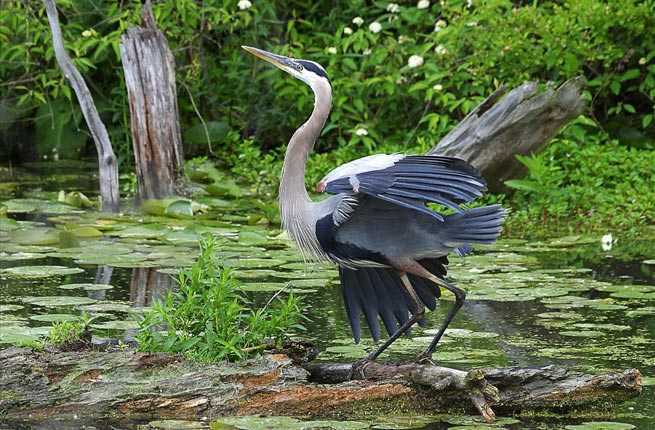
Cuyahoga Valley National Park, Ohio
Ohio
The 33,000-acre recreation area, and the only national park in Ohio, sprawls along 22 miles of the Cuyahoga River between Cleveland and Akron. You can take part in fishing, biking, camping, winter sports, horseback riding, and more. The 19.5-mile-long Ohio and Erie Canal Towpath Trail follows the canal's historic route and takes about 10 hours to hike. The trail is open 24 hours, allowing visitors the chance to explore after dark. There are five visitor facilities within the park that offer information, exhibits, and knowledgeable park rangers.
PLAN YOUR TRIP: Visit Fodor’s Cuyahoga Valley National Park Guide
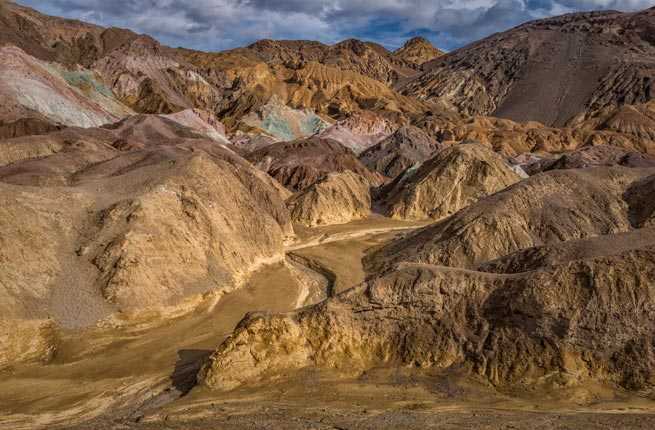
Death Valley National Park, California and Nevada
California and Nevada
The desert is no Disneyland. With its scorching summer heat and vast, sparsely populated tracts of land, it's not often at the top of the list when most people plan their California vacations. But the natural riches of Death Valley—the largest national park outside Alaska—are overwhelming: rolling waves of sand dunes, black cinder cones thrusting up hundreds of feet from a blistered desert floor, riotous sheets of wildflowers, bizarrely shaped Joshua trees basking in the orange glow of a sunset, tiny pupfish that enthrall youngsters, and a silence that is both dramatic and startling.
PLAN YOUR TRIP: Visit Fodor’s Death Valley National Park Guide

Denali National Park, Alaska
Alaska
Denali National Park and Preserve is Alaska's most visited attraction for many reasons. The most accessible of Alaska's national parks and one of only three connected to the state's highway system, the 6-million-acre wilderness offers views of mountains so big they seem like a wall on the horizon; endless wildlife, from cinnamon-color Toklat grizzlies to herds of caribou, to moose with antlers the size of coffee tables; glaciers with forests growing on them; autumn tundra the color of a kid's breakfast cereal.
PLAN YOUR TRIP: Visit Fodor’s Denali National Park Guide
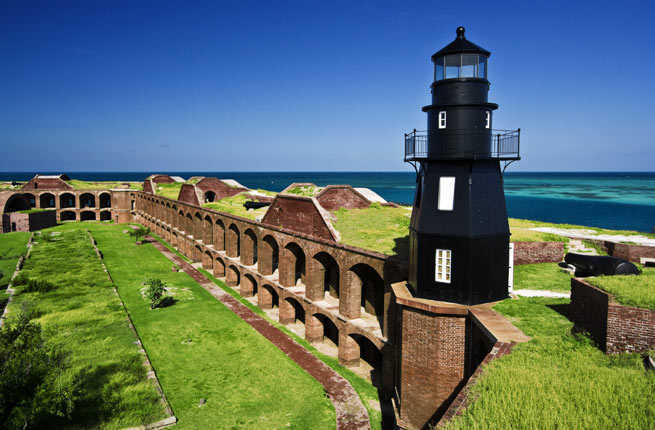
Dry Tortugas National Park, Florida
Florida
History buffs might remember long-deactivated Fort Jefferson as the prison that held Dr. Samuel Mudd for his role in the Lincoln assassination. But today's “guests” are much more captivated by this sanctuary's thousands of birds and marine life.
PLAN YOUR TRIP: Visit Fodor’s Dry Tortugas National Park Guide

Everglades National Park, Florida
Florida
If you're heading across South Florida on U.S. 41 from Miami to Naples, you'll breeze right through the Everglades. Also known as Tamiami Trail, this mostly two-lane road skirts the edge of Everglades National Park and cuts across the Big Cypress National Preserve. You'll also be near the park if you're en route from Miami to the Florida Keys on U.S. 1, which cuts through Homestead and Florida City—communities east of the main park entrance. Basically, if you're in South Florida, you can't escape at least fringes of the Everglades. With tourist strongholds like Miami, Naples, and the Florida Keys so close, travelers from all over the world typically make day trips to the park.
PLAN YOUR TRIP: Visit Fodor’s Everglades National Park Guide
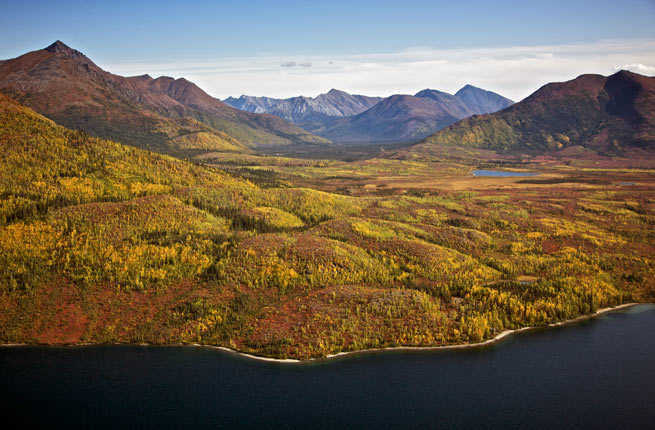
Gates of the Arctic National Park, Alaska
Alaska
The most northern national park in the country is a mountain-gazer and trekker’s dream. Even by Alaska standards of beauty, Gates of the Arctic National Park and Preserve offers truly epic scenery of endless, cragged peaks (once ancient seabed) and six different “Wild and Scenic” rivers. For instant respect with locals, hike the famed and arduous Anaktuvuk Pass.
PLAN YOUR TRIP: Visit Fodor’s Gates of the Arctic National Park Guide

Glacier National Park, Montana
Montana
The massive peaks of the Continental Divide in northwest Montana are the backbone of Glacier National Park and its sister park in Canada, Waterton Lakes, which together make up the International Peace Park. From their slopes, melting snow and alpine glaciers yield the headwaters of rivers that flow west to the Pacific Ocean, north to the Arctic Ocean, and southeast to the Atlantic Ocean via the Gulf of Mexico. Coniferous forests, thickly vegetated stream bottoms, and green-carpeted meadows provide homes and sustenance for all kinds of wildlife.
PLAN YOUR TRIP: Visit Fodor’s Glacier National Park Guide

Glacier Bay National Park, Alaska
Alaska
Near the northern end of the Inside Passage, Glacier Bay National Park and Preserve is one of America's most magnificent national parks. Visiting Glacier Bay is like stepping back into the Little Ice Age—it's one of the few places in the world where you can approach such a variety of massive tidewater glaciers. Sounding like cannon fire, bergs the size of 10-story office buildings come crashing from the “snout” of a glacier, each cannon blast signifying another step in the glacier's steady retreat. The calving iceberg sends tons of water and spray skyward, propelling mini–tidal waves outward from the point of impact. Johns Hopkins Glacier calves so often and with such volume that large cruise ships can seldom come within 2 miles of its face.
PLAN YOUR TRIP: Visit Fodor’s Glacier Bay National Park Guide
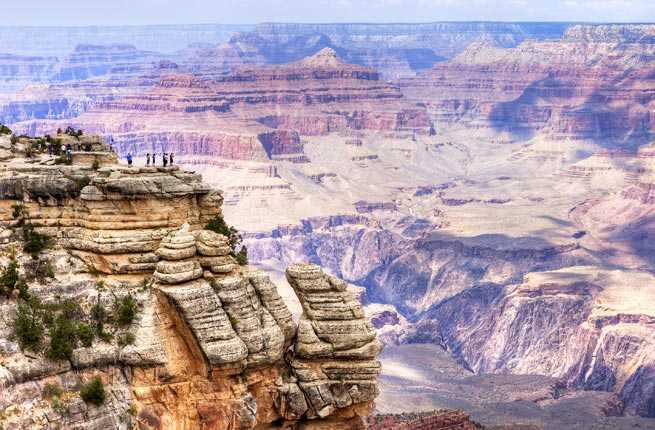
Grand Canyon National Park, Arizona
Arizona
When it comes to the Grand Canyon, there are statistics, and there are sensations. While the former are impressive—the canyon measures an average width of 10 miles, length of 277 river miles, and depth of 1 mile—they don't truly prepare you for that first impression. Seeing the canyon for the first time is an astounding experience, one that's hard to wrap your head around. In fact, it's more than an experience: it's an emotion, one that’s only just beginning to be captured with the word “Grand.” Hike or ride a trusty mule down into the canyon, bike or ramble along its rim, fly over, or raft through on the Colorado River—there are manifold ways to soak up the canyon's magnificence.
PLAN YOUR TRIP: Visit Fodor’s Grand Canyon National Park Guide
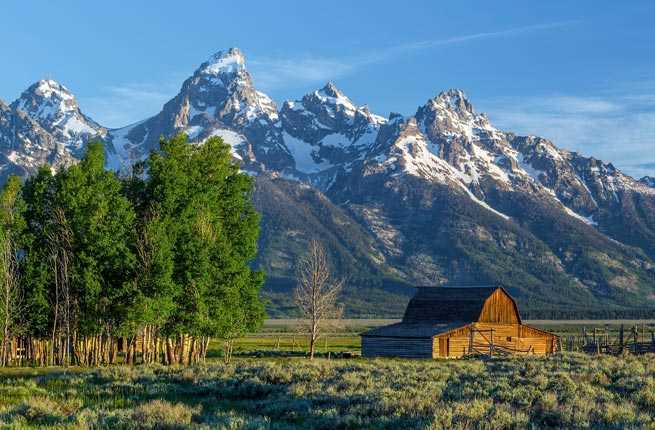
Grand Teton National Park, Wyoming
Wyoming
Your jaw might drop the first time you see the Teton Range rising above the Jackson Hole valley floor. With no foothills to get in the way, you'll have a close-up, unimpeded view of magnificent, jagged, snowcapped peaks. This massif is long on natural beauty, dominated by the 13,770-foot Grand Teton. Before your eyes, mountain glaciers creep down 12,605-foot Mt. Moran. Large and small lakes gleam along the range's base. Many of the West's iconic animals (elk, bears, bald eagles) call this park home.
PLAN YOUR TRIP: Visit Fodor’s Grand Teton National Park Guide

Great Basin National Park, Nevada
Nevada
As you drive the straight, desolate road into Great Basin National Park, it's hard not to feel moved—or at least tiny. Massive Wheeler Peak rises up 13,063 feet in front of you, as the terrain transitions from dry desert to alpine forest. There's plenty to see here, from the ancient, otherworldly bristlecone pines to the surreal formations in Lehman Caves. But the real beauty of Great Basin isn't its best-known attractions. It's the extraordinary solitude.
PLAN YOUR TRIP: Visit Fodor’s Great Basin National Park Guide
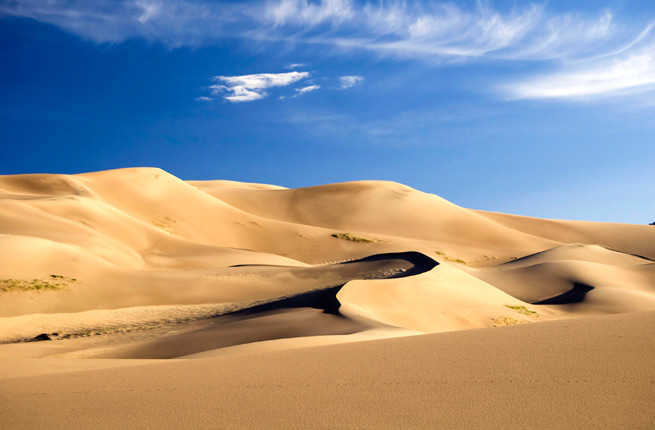
Great Sand Dunes National Park, Colorado
Colorado
Created by winds that sweep the San Luis Valley floor, the enormous sand dunes that form the heart of Great Sand Dunes National Park and Preserve are an improbable, unforgettable sight. The dunes, as curvaceous as Rubens's nudes, stretch for more than 30 square miles. Because they're made of sand, the dunes' very existence seem tenuous, as if they might blow away before your eyes, yet they're solid enough to have withstood 440,000 years of Mother Nature—and the modern stress of hikers and saucer-riding thrill seekers.
PLAN YOUR TRIP: Visit Fodor’s Great Sand Dunes National Park Guide
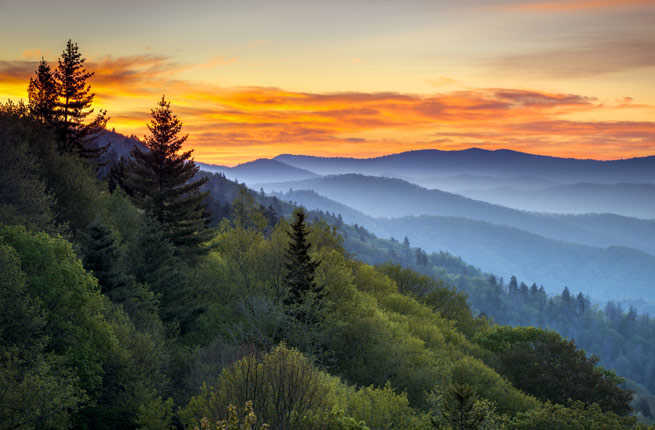
Great Smoky Mountains National Park, North Carolina and Tennessee
North Carolina and Tennessee
Great Smoky Mountains National Park is one of the great wild areas of the eastern United States and the most visited national park in the United States. From a roadside lookout or from a clearing in a trail, in every visible direction you can see the mountains march toward a vast horizon of wilderness. Some of the tallest mountains in the East are here, including 16 peaks over 6,000 feet. The highest in the park, Clingmans Dome, was reputedly the original inspiration for the folk song “On Top of Old Smoky.” It rises 6,643 feet above sea level and 4,503 feet above the valley floor. These are also some of the oldest mountains in the world, far older than the Rockies, the Alps, or the Andes. Geologists say the building of what are now the Great Smokies began about a billion years ago.
PLAN YOUR TRIP: Visit Fodor’s Great Smoky Mountains National Park Guide

Guadalupe Mountains National Park, Texas
Texas
Guadalupe Mountains National Park is a study in extremes: it has mountaintop forests but also rocky canyons, arid deserts, and a stream that winds through verdant woods. The park is home to the Texas madrone tree, found commonly only here and in Big Bend National Park. Guadalupe Mountains National Park also has the distinction of hosting the loftiest spot in Texas: 8,749-foot Guadalupe Peak. The mountain dominates the view from every approach, but it's just one member of a rugged range carved by wind, water, and time.
PLAN YOUR TRIP: Visit Fodor’s Guadalupe Mountains National Park Guide
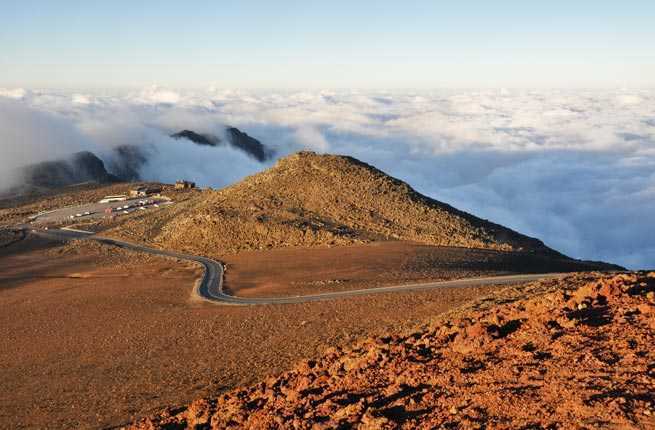
Haleakala National Park, Hawaii
Hawaii
Nowhere else on Earth can you drive from sea level to 10,023 feet in only 38 miles. And what's more shocking—in that short vertical ascent to the summit of the volcano Haleakala you'll journey from lush, tropical-island landscape to the stark, moonlike basin of the volcano's enormous, otherworldly crater. Established in 1916, Haleakala National Park covers an astonishing 33,222 acres, with the Haleakala Crater as its centerpiece. There's terrific hiking, including trails for one-hour, four-hour, eight-hour, and overnight hikes, one of which goes through the Waikamoi Cloud Forest on Thursday only and requires reservations (call the park line no more than a week in advance).
PLAN YOUR TRIP: Visit Fodor’s Haleakala National Park Guide

Hawaii Volcanoes National Park
Hawaii
Few visitors realize that in addition to “the volcano” (Kilauea)—that mountain oozing new layers of lava onto its flanks—there's also Volcano, the village. Conveniently located next to Hawaii Volcanoes National Park, Volcano Village is a charming little hamlet in the woods that offers a dozen or so excellent inns and bed-and-breakfasts, a decent (although strangely expensive) Thai restaurant, and a handful of things to see and do that don't include the village's namesake. If you plan to visit the Halemaumau summit crater at night (which you absolutely should if it's glowing), or drive down to the coast to try to see lava steaming into the sea, spending a night in Volcano Village is the ideal way to go about it.
PLAN YOUR TRIP: Visit Fodor’s Hawaii Volcanoes National Park Guide

Hot Springs National Park, Arkansas
Arkansas
Aside from being the smallest national park by area, Hot Springs is also the oldest park maintained by the National Park Service. The hot spring water has been popularly believed for centuries to possess medicinal properties, and was a subject of legend among several Native American tribes.
PLAN YOUR TRIP: Visit Fodor’s Hot Springs Guide
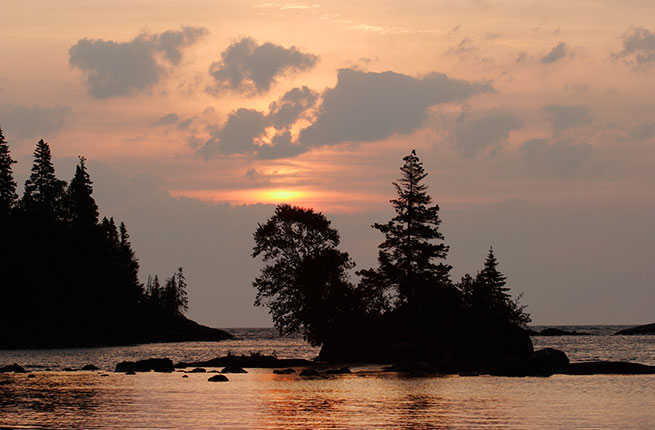
Isle Royale National Park, Michigan
Michigan
Isle Royale, the largest island on Lake Superior, is one big national park. The Greenstone Ridge Trail is a high ridge in the center that runs from one end of the island to the other. Gaze out over the rocky shoreline to the cobalt blue lakeand the 400 smaller surrounding islands. As one of the least well-known national parks, you’ll likely have the trails of Isle Royale to yourself.
PLAN YOUR TRIP: Visit Fodor’s Michigan Guide
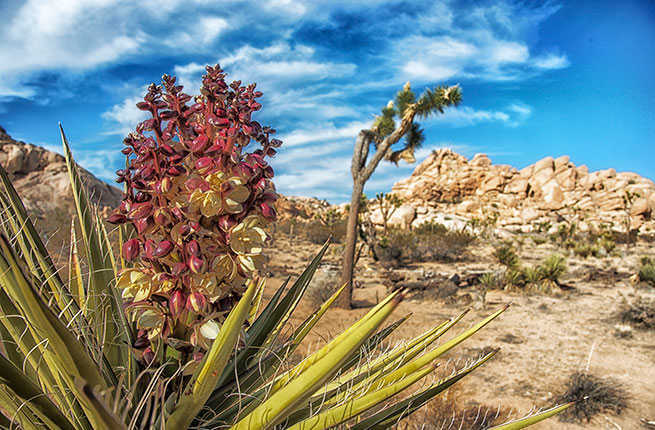
Joshua Tree National Park, California
California
Ruggedly beautiful desert scenery attracts more than a million visitors each year to Joshua Tree National Park, one of the last great wildernesses in the continental United States. Its mountains support mounds of enormous boulders and jagged rock; natural cactus gardens and lush oases shaded by tall fan palms mark the meeting place of the Mojave (high) and Sonora (low) deserts. Extensive stands of Joshua trees gave the park its name; the plants (members of the yucca family of shrubs) reminded Mormon pioneers of the biblical Joshua, with their thick, stubby branches representing the prophet raising his arms toward heaven.
PLAN YOUR TRIP: Visit Fodor’s Joshua Tree National Park Guide

Katmai National Park, Alaska
Alaska
Katmai is the most famous of Alaska's remote parks for two simple reasons: bears and volcanoes. Although Katmai sees only a fraction of the number of visitors to Denali National Park, its name echoes with mythical force to Alaskans. Katmai is true wilderness Alaska, a place many locals long to visit and very few have. Remote and expensive (even by Alaska travel standards) to reach, with limited visitor facilities (except for a few very nice wilderness lodges), once there you have Alaska to yourself. The price is certainly steep, but guaranteed to buy the trip of a lifetime. Katmai’s 4 million acres offer up plenty of opportunities for wildlife viewing and an extraordinary perspective on the awesome power of volcanoes—still active throughout the park.
PLAN YOUR TRIP: Visit Fodor’s Katmai National Park Guide

Kenai Fjords National Park, Alaska
Alaska
On the southeast side of the Kenai Peninsula, along the Gulf of Alaska, nearly 670,000 acres were designated as the Kenai Fjords National Park in 1980 as part of the Alaska National Interest Lands Conservation Act. Abundant wildlife thrives in these icy waters and dense forests. Evidence of the Ice Age can be seen everywhere, though, as the glaciers rapidly shrink, this is also where the effects of changing climates is also readily evident.
PLAN YOUR TRIP: Visit Fodor’s Kenai Fjords National Park Guide
Kings Canyon National Park, California
California
AlthoughSequoiadendron giganteum is the formal name for the redwoods that grow here, everyone outside the classroom calls them sequoias, big trees, or Sierra redwoods. Their monstrously thick trunks and branches, remarkably shallow root systems, and neck-craning heights are almost impossible to believe, as is the fact they can live for more than 2,500 years. Many of these towering marvels are in the Giant Forest stretch of Generals Highway, which connects Sequoia and Kings Canyon national parks. Kings Canyon has two portions: the smaller is shaped like a bent finger and encompasses Grant Grove Village and Redwood Mountain Grove (the two parks' largest concentration of sequoias), and the larger is home to stunning Kings River Canyon, whose vast, unspoiled peaks and valleys are a backpacker's dream.
PLAN YOUR TRIP: Visit Fodor’s Kings Canyon National Park Guide

Kobuk Valley National Park, Alaska
Alaska
Anything is possible in Alaska’s wildlands, even deserts. Kobuk Valley National Park is home to three sets of sand dunes, remnants of retreating glaciers from the Pleistocene epoch. But, as with everything else in Alaska, don’t expect the ordinary sandy scenery: Kobuk Valley’s dunes are now covered with the short trees, shrubs, and lichen typical of the tundra. An aerial tour of the Delaware-size park will display the beautiful winding Kobuk River, endless speckles of lakes, and perhaps also a wandering herd of caribou.
PLAN YOUR TRIP: Visit Fodor’s Kobuk Valley National Park Guide
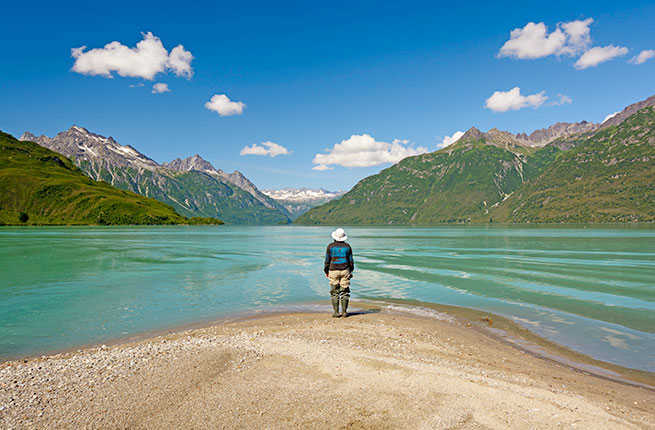
Lake Clark National Park, Alaska
Alaska
The 3.4 million acres on the Alaska Peninsula that comprise Lake Clark National Park and Preserve stretch from the coast to the heights of two grand volcanoes: Mt. Iliamna and Mt. Redoubt. The latter made headlines in 2009 when it erupted, sending ash floating over the region. Both volcanoes top out above 10,000 feet. The country in between holds glaciers, waterfalls, and turquoise-tinted lakes. The 50-mile-long Lake Clark, filled by runoff waters from the mountains that surround it, is an important spawning ground for thousands of red (sockeye) salmon.
PLAN YOUR TRIP: Visit Fodor’s Lake Clark National Park Guide

Lassen Volcanic Park, California
California
A dormant plug dome, Lassen Peak is the focus of Lassen Volcanic National Park. The peak began erupting in May 1914, sending pumice, rock, and snow thundering down the mountain, and gas and hot ash billowing into the atmosphere. Lassen's most spectacular outburst was in 1915 when it blew a cloud of ash almost 6 miles high. The resulting mudflow destroyed vegetation for miles in some directions; the evidence is still visible today, especially in Devastated Area. The volcano finally came to rest in 1921.
PLAN YOUR TRIP: Visit Fodor’s Lassen Volcanic National Park Guide
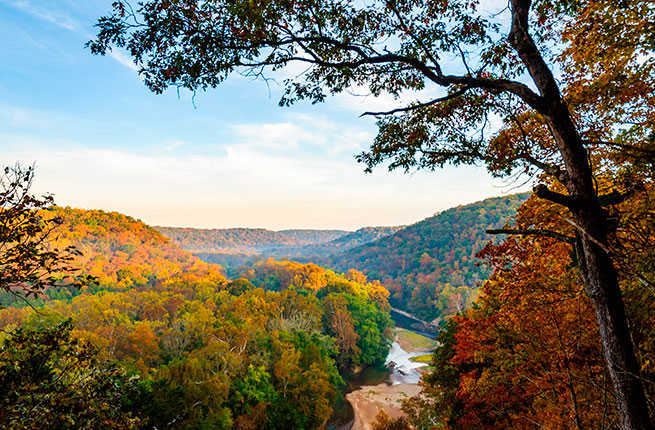
Mammoth Cave Park, Kentucky
Kentucky
Spanning a distance of more than 400 miles, Mammoth Cave is the longest cave system in the world, and the best place to experience a little stretch of this massive system is Mammoth Cave National Park. As Cave City's biggest attraction, it draws hoardes of tourists, and summertime cave tours can get crowded. The U.S. National Park Service offers a range of themed tours throughout the year to different sections of the cave, ranging from an easy quarter-mile to a physically demanding six-hour exploration. For safety reasons, backpacks and baby carriers are not allowed inside the caves.
PLAN YOUR TRIP: Visit Fodor’s Mammoth Cave National Park Guide
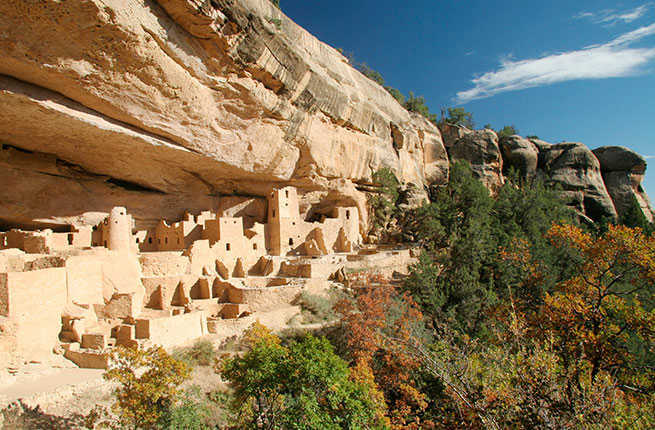
Mesa Verde National Park, Colorado
Colorado
Unlike the other national parks, Mesa Verde earned its status from its ancient cultural history rather than its geological treasures. President Theodore Roosevelt established it in 1906 as the first national park to “preserve the works of man,” in this case that of the Ancestral Puebloans, also known as the Anasazi. They lived in the region from roughly 550 to 1300; they left behind more than 4,000 archaeological sites spread out over 80 square miles. Their ancient dwellings, set high into the sandstone cliffs, are the heart of the park.
PLAN YOUR TRIP: Visit Fodor’s Mesa Verde National Park Guide

Mount Rainier National Park, Washington
Washington
Like a mysterious, white-clad chanteuse, veiled in clouds even when the surrounding forests and fields are bathed in sunlight, Mt. Rainier is the centerpiece of its namesake park. The impressive volcanic peak stands at an elevation of 14,411 feet, making it the fifth-highest peak in the lower 48 states. Nearly 2 million visitors a year enjoy spectacular views of the mountain and return home with a lifelong memory of its image.
PLAN YOUR TRIP: Visit Fodor’s Mount Rainier National Park Guide

North Cascades National Park, Washington
Washington
Countless snow-clad mountain spires dwarf narrow glacial valleys in this 505,000-acre expanse of the North Cascades, which encompasses three diverse natural areas. North Cascades National Park is the core of the region, flanked by Lake Chelan National Recreation Area to the south and Ross Lake National Recreation Area to the north; all are part of the Stephen T. Mather Wilderness Area. It’s a spectacular gathering of snowy peaks, glacial meadows, plunging canyons, and cold, deep-blue lakes. Traditionally the lands of several American Indian tribes, it's fitting that it's still completely wild—and wildlife-filled.
PLAN YOUR TRIP: Visit Fodor’s North Cascades National Park Guide

Olympic National Park, Washington
Washington
A spellbinding setting is tucked into the country's far-northwestern corner, within the heart-shape Olympic Peninsula. Edged on all sides by water, the forested landscape is remote and pristine, and works its way around the sharpened ridges of the snowcapped Olympic Mountains. Big lakes cut pockets of blue in the rugged blanket of pine forests, and hot springs gurgle up from the foothills. Along the coast the sights are even more enchanting: wave-sculpted boulders, tidal pools teeming with sea life, and tree-topped sea stacks.
PLAN YOUR TRIP: Visit Fodor’s Olympic National Park Guide
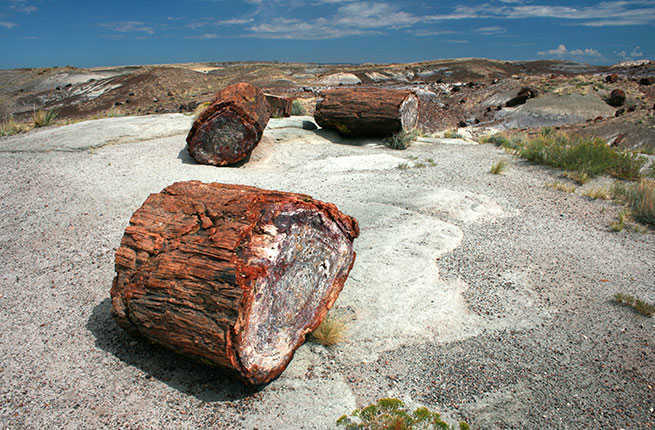
Petrified Forest National Park, Arizona
Arizona
Petrified logs scattered about a vast pink-hued lunarlike landscape resemble a fairy-tale forest turned to stone at Petrified Forest National Park. The park's 218,533 acres, which include portions of the Painted Desert, are covered with petrified tree trunks whose wood cells were fossilized over centuries by brightly hued mineral deposits—silica, iron oxide, carbon, manganese, aluminum, copper, and lithium. The park holds plenty of other fossils; remnants of humans and their artifacts have been recovered at more than 500 sites in the park.
PLAN YOUR TRIP: Visit Fodor’s Petrified Forest National Park Guide
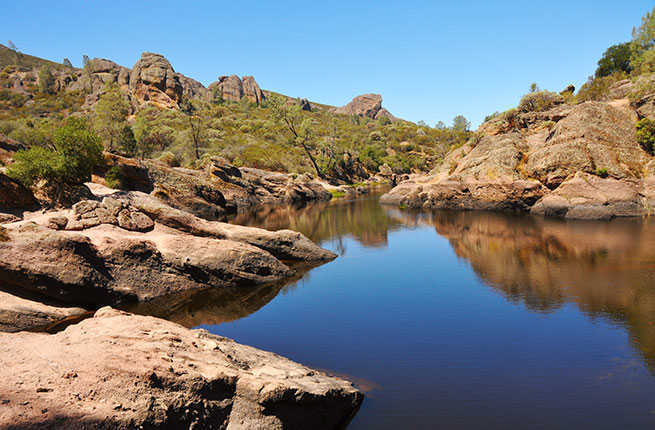
Pinnacles National Park, California
California
Pinnacles may be our nation’s newest national park, but Teddy Roosevelt recognized the uniqueness of this ancient volcano—its jagged spires and monoliths thrusting upward from chaparral-covered mountains—when he made it a national monument in 1908. Legends abound of robbers and banditos who used the park’s talus caves as hideouts, though undoubtedly the park’s most famous denizens today are the singularly magnificent California condors, which were all but extinct just 25 years ago. Though only about two hours from the bustling Bay Area, the outside world seems to recede even before you reach the park’s gates.
PLAN YOUR TRIP: Visit Fodor’s Pinnacles National Park Guide

Redwood National Park, California
California
Soaring to more than 300 feet, the coastal redwoods that give this park its name are miracles of efficiency—some have survived hundreds of years (a few live for more than 2,000 years). These massive trees glean nutrients from the rich alluvial flats at their feet and from the moisture and nitrogen trapped in their uneven canopy. Their huge, thick-barked trunks can hold thousands of gallons of water, reservoirs that have helped them withstand centuries of firestorms.
PLAN YOUR TRIP: Visit Fodor’s Redwood National Park Guide

Rocky Mountain National Park, Colorado
Colorado
Anyone who delights in alpine lakes, dense forests, and abundant wildlife—not to mention dizzying heights—should consider Rocky Mountain National Park. Here, a single hour's drive leads from a 7,800-foot elevation at park headquarters to the 12,183-foot apex of the twisting and turning Trail Ridge Road. More than 355 miles of hiking trails take you to the park's many treasures: meadows flush with wildflowers, cool dense forests of lodgepole pine and Engelmann spruce, and the noticeable presence of wildlife, including elk and bighorn sheep.
PLAN YOUR TRIP: Visit Fodor’s Rocky Mountain National Park Guide
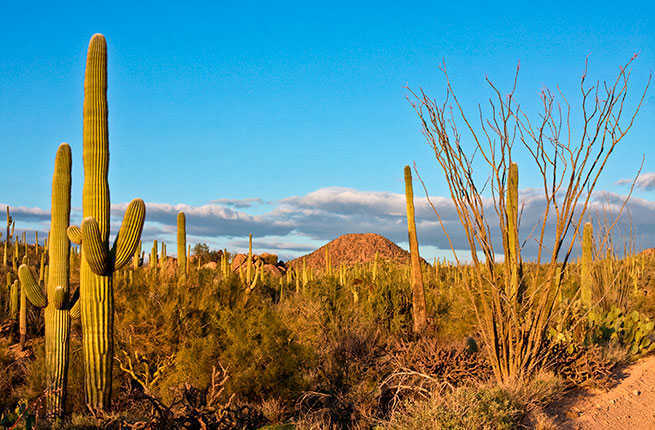
Saguaro National Park, Arizona
Arizona
Standing sentinel in the desert, the towering saguaro is perhaps the most familiar emblem of the Southwest. Known for their height (often 50 feet) and arms reaching out in weird configurations, these slow-growing giants can take 15 years to grow a foot high and up to 75 years to grow their first arm. A typical saguaro lives 150 years, but many survive more than 200 years. They are found only in the Sonoran Desert, and the largest concentration is in Saguaro National Park. In late spring (usually May), the succulent's top is covered with tiny white blooms—the Arizona state flower. The cacti are protected by state and federal laws, so don't disturb them.
PLAN YOUR TRIP: Visit Fodor’s Saguaro National Park Guide
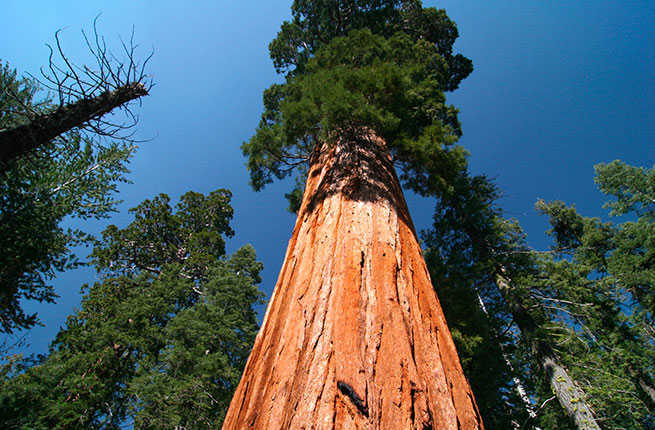
Sequoia National Park, California
California
AlthoughSequoiadendron giganteum is the formal name for the redwoods that grow here, everyone outside the classroom calls them sequoias, big trees, or Sierra redwoods. Their monstrously thick trunks and branches, remarkably shallow root systems, and neck-craning heights are almost impossible to believe, as is the fact they can live for more than 2,500 years. Many of these towering marvels are in the Giant Forest stretch of Generals Highway, which connects Sequoia and Kings Canyon national parks. Sequoia includes Mt. Whitney, the highest point in the Lower 48 states (although it is impossible to see from the western part of the park and is a chore to ascend from either side).
PLAN YOUR TRIP: Visit Fodor’s Sequoia National Park Guide

Shenandoah National Park, Virginia
Virginia
Though Shenandoah National Park is only a narrow ribbon on the map, stretching 70 miles along the Blue Ridge but rarely more than 5 mi wide, it is easy to imagine being much deeper in the wilderness as you travel through it or spend a night camping here. Steep, wooded ridges with rocky slopes stand out in the foreground of vistas taking in the Shenandoah Valley to the west and the Piedmont to the east. Skyline Drive traverses the park end to end, from Waynesboro to Front Royal, and is the most common way to see the park. But hikers can find beautiful terrain just yards from the drive on some of the park's 500 mi of trails, trout fishers may wade into more than 25 streams, and riders can rent horses for wilderness trail rides. Those who want to know more about the area's flora and fauna may want to take a guided hike, which naturalists lead daily throughout the season.
PLAN YOUR TRIP: Visit Fodor’s Shenandoah National Park Guide

Theodore Roosevelt National Park, North Dakota
North Dakota
For a century and a quarter, the terrain remained virtually unchanged from the day Theodore Roosevelt stepped off the train here in 1883, eager to shoot his first bison. Within two weeks, the future 26th president purchased an open-range cattle ranch, and the following year he returned to establish a second, which is part of the 110-square-mile national park that today bears his name. Roosevelt became dedicated to the preservation of the animals and land he saw devastated by hunting and overgrazing. He established the U.S. Forest Service and signed into law 150 national forests, 51 bird reserves, 4 game preserves, 5 national parks, and established 18 national monuments. Theodore Roosevelt National Park was created in 1947 to commemorate his efforts.
PLAN YOUR TRIP: Visit Fodor’s Theodore Roosevelt National Park Guide
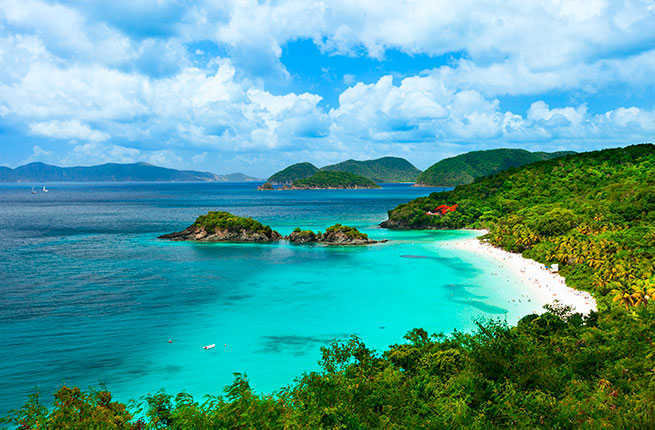
Virgin Islands National Park, U.S. Virgin Islands
U.S. Virgin Islands
St. John's heart is Virgin Islands National Park, a treasure that takes up a full two-thirds of St. John's 20 square miles (53 square km). The park was spearheaded by Laurance S. Rockefeller and Frank Stick and was finally handed over to the Department of the Interior in 1956. The park helps keep the island's interior in its pristine and undisturbed state, but if you go at midday you'll probably have to share your stretch of beach with others, particularly at Trunk Bay.
PLAN YOUR TRIP: Visit Fodor’s St. John Guide

Voyageurs National Park, Minnesota
Minnesota
The park's name commemorates the voyageurs, French-Canadian fur traders who were the first European settlers to frequently travel through the area. The park is notable for its outstanding water resources and is popular with canoeists, kayakers, other boaters and fishermen. Here you can see and touch rocks half as old as the world, experience the life of a voyageur, immerse yourself in the sights and sounds of a boreal forest, view the dark skies, or ply the interconnected water routes.
PLAN YOUR TRIP: Visit Fodor’s Minnesota Guide
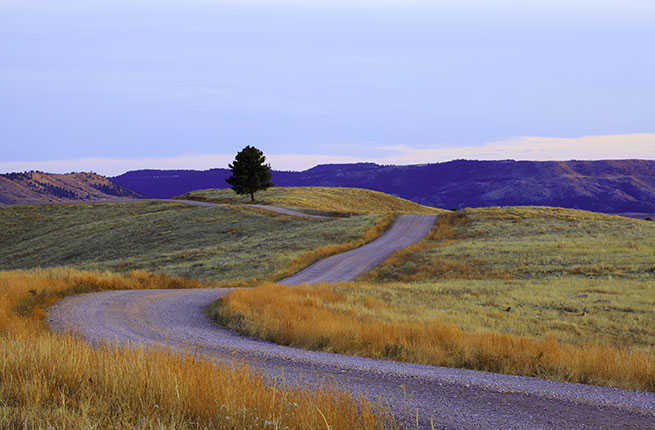
Wind Cave National Park, South Dakota
South Dakota
If you don't get out of your car at Wind Cave, you haven't scratched the surface—literally. The park has more than 141 miles of underground passageways. Curious cave formations include 95% of the world's mineral boxwork, and gypsum beard so sensitive it reacts to the heat of a lamp. This underground wilderness is part of a giant limestone labyrinth beneath the Black Hills. Wind Cave ranks as the sixth-longest cave in the world, but experts believe 95% of it has yet to be mapped.
PLAN YOUR TRIP: Visit Fodor’s Wind Cave National Park Guide
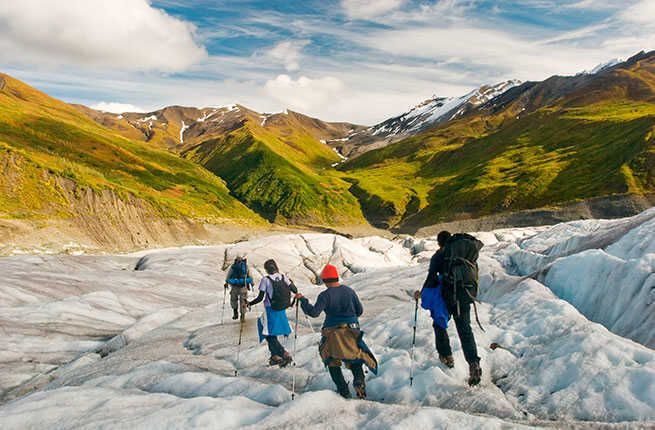
Wrangell-St. Elias National Park, Alaska
Alaska
In a land of many grand and spectacularly beautiful mountains, those in the 13.2-million-acre Wrangell–St. Elias National Park and Preserve are possibly the finest of them all. This extraordinarily compact cluster of immense peaks belongs to four different mountain ranges. Rising through many ecozones, the Wrangell–St. Elias Park and Preserve is largely undeveloped wilderness parkland on a grand scale. The area is perfect mountain-biking and primitive-hiking terrain, and the rivers invite rafting for those with expedition experience. The mountains attract climbers from around the world—whereas Alaska's mountains have been summited many times over, there is the opportunity here to be the first or one of few to summit.
PLAN YOUR TRIP: Visit Fodor’s Wrangell–St. Elias National Park Guide
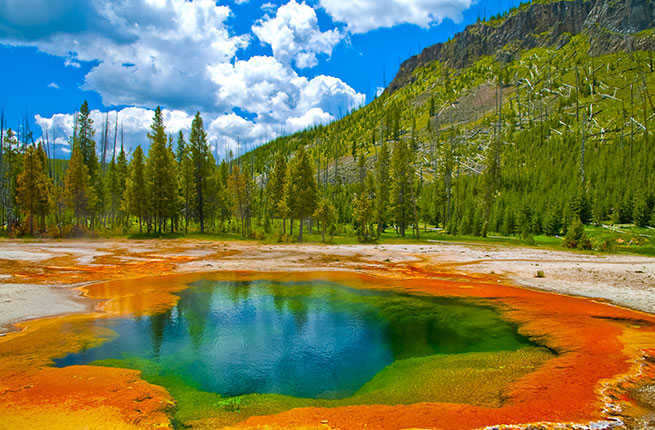
Yellowstone National Park, Wyoming
Wyoming
A trip to Yellowstone has been a rich part of the American experience for five generations now. Though it's remote, we come—more than 3,000,000 strong—year after year. When we arrive, we gasp at the incomparable combination of natural beauty, rugged wilderness, majestic peaks, and abundant wildlife. Indescribable geysers, mud pots, fumaroles, and hot springs make this magma-filled pressure cooker of a park unlike any place else on earth. If you're not here for the geysers, chances are that you've come to spot some of the teeming wildlife, from grazing bison to cruising trumpeter swans.
PLAN YOUR TRIP: Visit Fodor’s Yellowstone National Park Guide

Yosemite National Park, California
California
By merely standing in Yosemite Valley and turning in a circle, you can see more natural wonders in a minute than you could in a full day pretty much anywhere else. Half Dome, Yosemite Falls, El Capitan, Bridalveil Fall, Sentinel Dome, the Merced River, white-flowering dogwood trees, maybe even bears ripping into the bark of fallen trees or sticking their snouts into beehives—it's all in Yosemite Valley.
PLAN YOUR TRIP: Visit Fodor’s Yosemite National Park Guide

Zion National Park, Utah
Utah
The walls of Zion Canyon soar more than 2,000 feet above the valley below, but it's the character, not the size, of the sandstone forms that defines the park's splendor. Throughout the park, stratigraphic evidence points to the distant past, with fantastically colored bands of limestone, sandstone, and lava. Stripes and spots of greenery high in the cliff walls create a “hanging garden” effect, and invariably indicate the presence of water seepage or a spring. Erosion has left behind a collection of domes, fins, and blocky massifs bearing the names and likenesses of cathedrals and temples, prophets and angels.
PLAN YOUR TRIP: Visit Fodor’s Zion National Park Guide




